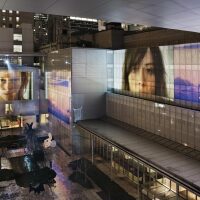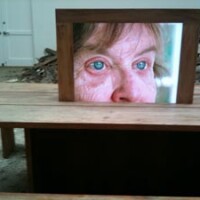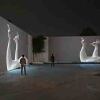Electric Earth: Doug Aitken Explores How We Communicate with Nature and with Each Other

"I Only Have Eyes For You" fills MOCA's Geffen Contemporary. Forty different versions of the song were commissioned by Doug Aitken for the installation "Song 1" (2012). Visitors can, and do, sit underneath a cylinder screen that hangs near the entrance of "Electric Earth," Aitken's career-spanning survey running at the Little Tokyo museum. They can watch Tilda Swinton, or any other number of performers take on the song best known as a 1959 hit from The Flamingos. Or, they can let music follow them as they roam throughout the large, warehouse-like space.
Born in Redondo Beach and based in Los Angeles, Aitken explores contemporary issues, like technology's role in human communication or environmental concerns, through sculpture, film and large installations. His works often connect to each other in subtle ways, allowing "Electric Earth" to come together as not just a retrospective, but a larger statement about communication between humans, and between us and nature.
In "Song 1," the old, popular tune never sounds as it would on the radio. Covers bleed together to form a loop. Vocals are filtered, cut-up and stretched out until they sound spectral. At first, it may sound like the ghosts of doo-wop are following you. The "sha-bop sha-bop" lines blur together, forming something more like "shwap." If you hear this while entering the "99¢ Dreams" room of photography, the music heightens the forlorn nature of the photos. There are images arranged by color or light themes lining all the walls in this makeshift mini-gallery.


In one section, tiny glimpses of light mark moody photos. In one image, sun rays filter through a sheer curtain and pour across a table covered in broken glass. In others, the brightness of the outside world is visible through airplane-style windows. Across the room, it's shades of blue that overtake the wall, the hue coming from oceans, sky and even a pair of jeans.
When the photos depict the loneliness of human faces, "Song 1" and "99¢ Dreams" feel as though they have merged together as one installation. After a while, though, that song becomes part of the ambiance inside the exhibition. It's just a hum in the background, overshadowed by light sculptures and photographs altered with chemicals like Prozac, Ambien and Codeine.
In a small theater installation, "Black Mirror" (2011) plays on three screens. The short films star Chloe Sevigny as an anonymous traveler. Her excursions play out in slightly different ways on the monitors. One video might feature a close-up of Sevigny while another will show her a little further back. One split-second image might be missing from one video too. Still, this theater is mirrored, so the viewer is surrounded by reflected images that don't quite match. It demands your full attention, even after you realize that you will inevitably blink and miss a piece of information. At one point, you will hear a snippet of "I Only Have Eyes for You," linking together "Black Mirror" with "Song 1."
Offshore from Catalina Island, exhibiting concurrently with "Electric Earth," is Aitken's most recent installation, "Underwater Pavilions." The work was co-produced by Parley for the Oceans, an organization that brings together creative forces to raise awareness for ocean conservation, and is comprised of three sculptures that rest underwater. The large pieces look like mirrored, hollow rocks that swimmers can glide through. In a corresponding film that plays as part of "Electric Earth," a large school of fish swarms a sculpture. Some move around it. Others swim through it. The school's numbers, though, are hard to fathom as images reflect off the mirrored panels.
"Underwater Pavilions" recalls Aitken's 2009 site-specific work "Sonic Pavilion." That's a glass and steel structure erected in Brazil with microphones buried deep underground to record the earth. Some of those sounds play inside a nearly-hidden corner of the "Electric Earth" exhibition.
In projects like these, Aitken's art is a means of bringing to light parts of nature that may escape the average eye or ear. In "Underwater Pavilions," he captures a habitat that would remain unseen to those who don't dive in the ocean off of Catalina. With "Sonic Pavilion," which sits inside the Inhotim museum and botanical garden campus in Brumadinho, Brazil, he's not capturing the sound of the rain forest, but of the earth beneath it. It's a chance to hear the world move in a way that one normally could not.
Aitken's work often deals with information overload and superficial communication. In these environmental pieces, Aitken takes the observer deeper. Literally.
But, that's the overall vibe of "Electric Earth." It's dark and almost overwhelmed by one song played many different ways, ultimately dragging the audience into situations where you have to pay attention. You can't just scroll past an image, like you would on Facebook, or click away from a sound as you might on YouTube. "Electric Earth" becomes the antithesis of communication in 2016.








Dig this story? Sign up for our newsletter to get unique arts & culture stories and videos from across Southern California in your inbox. Also, follow Artbound on Facebook, Twitter, and Youtube.








